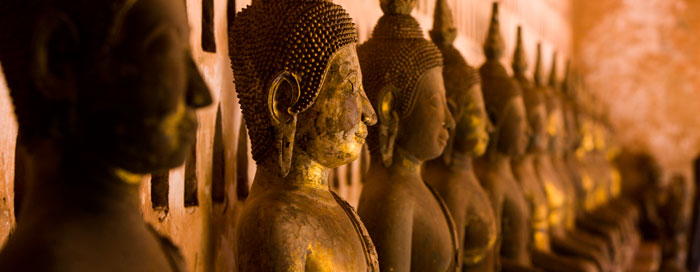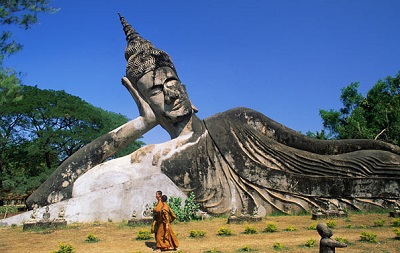If you’re expecting the usual hectic Asian capital you’ll be surprised by Vientiane’s quiet, laid back atmosphere. As the nation’s capital it is the largest city in Laos, but somehow manages to maintain its charm and sedate pace as it develops into a modern city.
French Influence By the Mekong River
The French influence is immediately evident with the wide tree lined streets and café culture, but you’ll also see Thai, Chinese and Soviet architecture that gives the city a rare type of timelessness. Against this background artsy little  cafes, restaurants and galleries are springing up as the city embarks on a new stage of life. These are all below the surface, waiting to be discovered as you explore the city on foot.
cafes, restaurants and galleries are springing up as the city embarks on a new stage of life. These are all below the surface, waiting to be discovered as you explore the city on foot.
Staying in Vientiane there is enough for a busy couple of days and tour highlights include the beautiful Wat Si Saket, whose walls are home to thousands of miniature Buddha statues and is the only temple left intact after the Siamese invasion in 1828. Then there’s Ho Phra Keo, a religious museum showcasing a fine collection of Lao and Khmer art. Continue on to Patouxai, the Victory Monument, with panoramic views of town. Finally end up at Pha That Luang, the holiest site in Laos and its national symbol.
Xieng Khouan Buddha Park
 A full day tour will also include Xieng Khouan Buddha Park. Here a renegade monk formed his own sect and began to carve magnificent, eerie statues out of concrete, based on Hindu, Buddhist and Brahman iconography. He began in 1958 and continued on until the Communist takeover of Laos in 1975, when he fled across the border to Nong Khai, Thailand and sculpted a new park. This is a surreal “Buddhisneyland” full of interesting photographic opportunities!
A full day tour will also include Xieng Khouan Buddha Park. Here a renegade monk formed his own sect and began to carve magnificent, eerie statues out of concrete, based on Hindu, Buddhist and Brahman iconography. He began in 1958 and continued on until the Communist takeover of Laos in 1975, when he fled across the border to Nong Khai, Thailand and sculpted a new park. This is a surreal “Buddhisneyland” full of interesting photographic opportunities!
Away from historical sites a visit to the Talat Sao market, where silk and silver jewellery is sold is particularly popular. You should also try to squeeze in a visit to the excellent COPE National Rehabilitation Centre that offers support, training and confidence to those maimed by the unexploded ordnance left as a legacy after American bombing during the Vietnam War. The effect on day-to-day life is further highlighted by the fascinating UXB exhibition.
Food is never far away and the collision of cultures in Vientiane has resulted in a superb variety of restaurants, so make sure you take to the streets to sample the choice available, perhaps stopping for a drink and watching the sun set over the seemingly ever present Mekong River.

